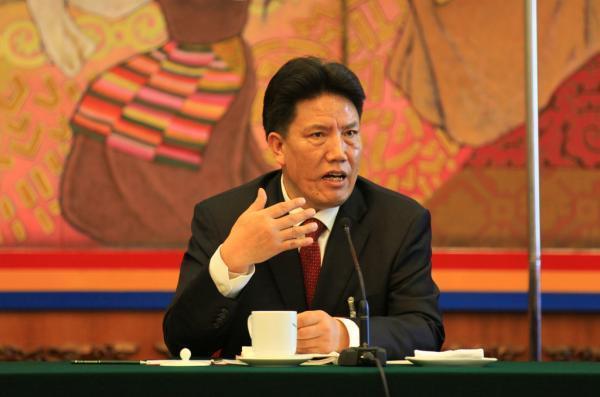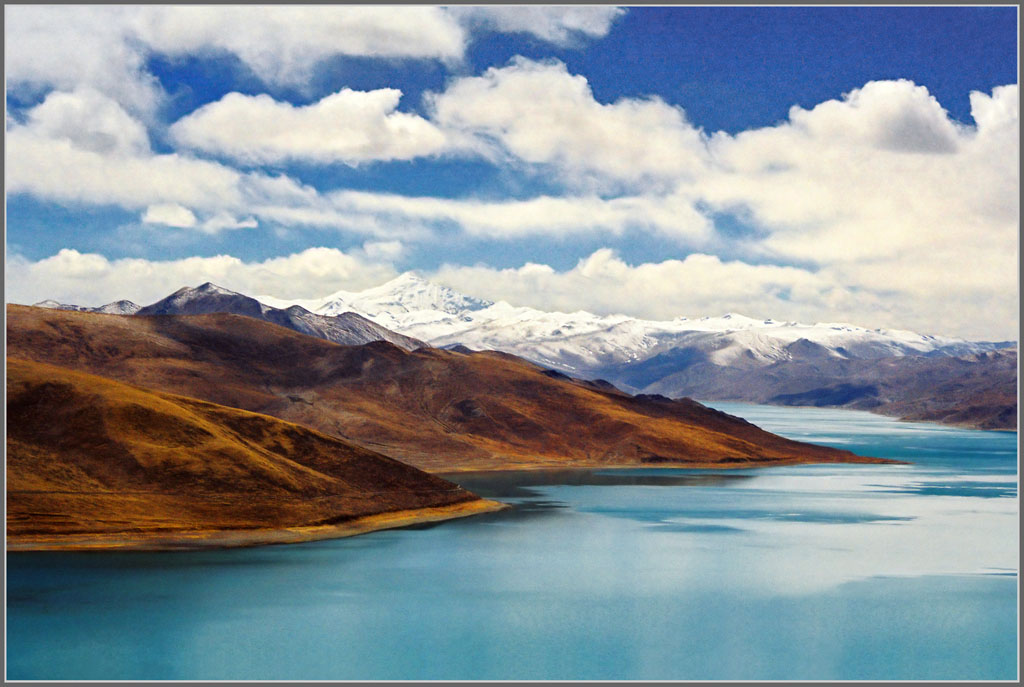Losang Jamcan: Environment protection is priority
Tibet’s total output value breaking hundred billion yuan, keeping growth at double digits
The total output value in Tibet surpassed the hundred billion yuan mark in 2015, with a growth rate at 11%. According to Chairman Losang Jamcan, it was an amazing achievement considering Tibet’s lack of economic foundation, late start, limitations in transportation and natural environment, etc. With help from the central government and the rest of the country, and with Tibetans’ own hard work, Tibet has been able to maintain growth at double digits with quality and efficiency.
Only 13 hours from Chengdu to Lhasa on the Sichuan-Tibet Railroad
Losang Jamcan talked about the Sichuan-Tibet Railroad project, part of the major construction planned for the “13th Five-Year Plan.” Some have said that this railroad is similar to building the world’s most difficult rollercoaster among the most dangerous and severe mountains and valleys in the world. Losang Jamcan has asked to start the railroad project multiple times during the Two Sessions. He said that turning Tibet into a major route toward South Asia has been a topic for the 6th Forum on Tibetan Work, in the “13th Five-Year Plan,” and in the “One Belt, One Road” program. This route will primarily be a railroad. There is already the Qinghai-Tibet Railroad on the Ancient Tea Horse Road and the Tang Bo Road, with the Sichuan-Tibet Railroad beginning construction toward Tibet, going from Chengdu to Lhasa will eventually only take 13 hours. This railroad will be crucial for enriching the lives of the Tibetan people and is eagerly awaited by all.
70% of financial resources devoted to improving people’s lives
Losang Jamcan said that in the past few years, over 70% of the financial resources in Tibet were devoted to improving people’s lives, with three major accomplishments: achieving 15-years of free education for all, moving all widowed and welfare-receiving seniors to county-level retirement homes if they were willing, and moving all orphans to region-level orphanages. Concentrating the allocation of educational and medical resources has helped achieve the fair distribution of endowment insurance among the town and rural residents.
Results tied to County Chairman’s Performance
Tibet is the only province-level region in China with poverty in concentrated population areas; the number of poverty-stricken people and the difficulty in poverty relief is a challenge in developing the Tibetan economy. During the “12th Five-Year Plan,” Tibet has made major strides toward poverty-relief and reduced the number of people suffering from poverty to only 580 thousand.
Losang Jamcan also commented that the information on every poverty-stricken family is kept on file with the village, town, county, and the Poverty-Relief Bureau at Tibet Autonomous Region. Everyone’s information is organized; data on personal income, ways of income generation, and the latest updates are connected to the province chairman’s performance. Leaders who have made improvements could be promoted, those who haven’t will need to make place for new leaders who can make a difference. Anyone who has not achieved results will be relieved of duty.
Turning resource advantage into industry advantage
Losang Jamcan said that Tibet is the last unpolluted area on earth and a precious resource. The region’s natural drinking water, clean energy, animals such as bison, Tibetan sheep, pigs, and chickens, vegetables like potatoes and sorghum are unique to the Tibet plateau. If they could be turned into product lines, and investment made in the industry chain and related processing technology, Tibet’s resource advantage could be made into industry advantage.
Environment protection is priority
Losang Jamcan remarked that Tibet is the safety net for China’s environmental protection efforts, with one-third of the region in the protection zone, environmental protection is a priority for Tibet. Tibet has strictly followed protection guidelines in not approving any “Triple High” companies (high pollution, high energy use, high emission). Mining resources could only be approved by the chairman of the Tibet Autonomous Region, and requires approval from the standing committee as well. Losang Jamcan said he has not approved any mining programs in the three years since he has been the chairman.
Your Comment
Name E-mailRelated News
-
;
-
-

-
Treat environment 'as our lifeline', Xi says
President Xi Jinping said the local government is duty-bound to protect the ecological environment on the Qinghai-Tibet Plateau, especially in the Sanjiangyuan area, where the Yangtze, Yellow and Mekong rivers originate.
-
-
-

-
Tibet chairman vows further eco-environment protection
How to achieve the green development of Tibet has become a hot issue among deputies to the ongoing session of the National People's Congress (NPC) in Beijing.
-
-
-

-
Environment at Qinghai Lake improves
The Qinghai Lake has adapted to climate change and made major improvements with the help from local government.
-
-
-

-
Tibet invests billions in environmental protection
On Feb. 22nd Tibet Autonomous Region Environmental Protection Department revealed that, up to the end of the 12th Five Year Period Tibet had invested a total of 18.8 billion yuan in ecological compensation.
-
Based in Lhasa, Tibet Vista is a Tibet travel agency that specialized in Tibet permit, and Tibet tours for both private and group travelers at a local price!
•4 Days Lhasa City Group Tour from USD 460 •8 Days Everest Base Camp Group Tour from USD 850 •15 Days Mt.Kailash Group Tour from USD 1780 •2016 Tibet Train Tours from Beijing, Shanghai, Chengdu, Xining,etc










